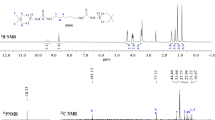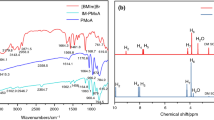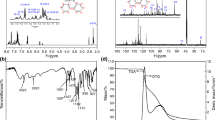Abstract
Over the past few decades, the development of highly efficient phosphorus-based flame retardants has become one of the research focuses in the field of halogen-free flame-retardant polymer technology. In this work, three kinds of 9,10-dihydro-9-oxa-10-phosphaphenanthrene-10-oxide (DOPO)-based derivatives were synthesized through integrating multiple phosphorous oxidation states into one molecular structure. The influence of DOPO-based derivatives on the thermal decomposition and flame-retardant properties of EP composites were investigated. DOPO-based derivatives promoted the slightly earlier decomposition of the epoxy matrix, resulting in better thermal stability at high temperatures and higher char yield. The unmodified EP showed a LOI value of 27.0% and no UL-94 rating, while all the EP composites containing 2 wt.% DOPO-based derivatives passed the UL-94 V-0 rating and achieved a LOI value of higher than 30.0%. Among the three DOPO-based derivatives, TDCA-DOPO-2 behaved the best flame-retardant efficiency owing to the highest synergistic effect. Specifically, the peak of heat release rate, total heat release and average effective heat combustion (av-EHC) of EP/TDCA-DOPO-2 was 62.0%, 54.2% and 39.9% lower than those of the unmodified EP, respectively. The high flame-retardant efficiency of DOPO-based derivatives was ascribed to the synergism between the barrier effect in the condensed phase (proved by the high yield and stability of char residues) and the flame inhibition effect in the gaseous phase (proved by the decreased av-EHC values).












Similar content being viewed by others
References
Kong QH, Zhu HJ, Huang S, Wu T, Zhu F, Zhang YL, Wang Y, Zhang JH (2022) Influence of multiply modified FeCu-montmorillonite on fire safety and mechanical performances of epoxy resin nanocomposites. Thermochim Acta 707:179112
Ogbonna VE, Popoola API, Popoola OM, Adeosun SO (2022) A review on corrosion, mechanical, and electrical properties of glass fiber-reinforced epoxy composites for high-voltage insulator core rod applications: challenges and recommendations. Polym Bull 79(9):6857–6884
Rahman MM, Akhtarul Islam M (2022) Application of epoxy resins in building materials: progress and prospects. Polym Bull 79(3):1949–1975
Wang X, Hu Y, Song L, Xing WY, Lu HD, Lv P, Jie GX (2010) Flame retardancy and thermal degradation mechanism of epoxy resin composites based on a DOPO substituted organophosphorus oligomer. Polymer 51(11):2435–2445
Liu SH, Yu B, Feng YC, Yang ZH, Yin BL (2019) Synthesis of a multifunctional bisphosphate and its flame retardant application in epoxy resin. Polym Degrad Stabil 165:92–100
Ma C, Qiu SL, Wang JL, Sheng HB, Zhang Y, Hu WZ, Hu Y (2018) Facile synthesis of a novel hyperbranched poly(urethane-phosphine oxide) as an effective modifier for epoxy resin. Polym Degrad Stabil 154:157–169
Balabanovich AI, Hornung A, Merz D, Seffert H (2004) The effect of a curing agent on the thermal degradation of fire retardant brominated epoxy resins. Polym Degrad Stabil 85:713–723
Howell BA, Han XR (2020) Effective biobased phosphorus flame retardants from starch-derived bis-2,5-(hydroxymethyl) furan. Molecules 25:592
Schmidt C, Ciesielski M, Greiner L, Döring M (2018) Novel organophosphorus flame retardants and their synergistic application in novolac epoxy resin. Polym Degrad Stabil 158:190–201
Howell BA, Alrubayyi A (2019) 2-Dopyl-1,4-di(2-dopylpropanoyl)benzene, an effective phosphorus flame retardant. Polym Degrad Stabil 162:196–200
Arora S, Mestry S, Naik D, Mhaske ST (2019) o-Phenylenediamine-derived phosphorus-based cyclic flame retardant for epoxy and polyurethane systems. Polym Bull 77(6):3185–3205
Velencoso MM, Battig A, Markwart JC, Schartel B, Wurm FR (2018) Molecular firefighting-how modern phosphorus chemistry can help solve the challenge of flame retardancy. Angew Chem Int Edit 57:10450–10467
Yang HY, Song L, Tai QL, Wang X, Yu B, Yuan Y, Hu Y, Yuen RKK (2014) Comparative study on the flame retarded efficiency of melamine phosphate, melamine phosphite and melamine hypophosphite on poly(butylene succinate) composites. Polym Degrad Stabil 105:248–256
Xu W, Wang GJ (2016) Influence of thermal behavior of phosphorus compounds on their flame retardant effect in PU rigid foam. Fire Mater 40:826–835
Braun U, Balabanovich AI, Schartel B, Knoll U, Artner J, Ciesielski M, Doring M, Perez R, Sandler JKW, Altstadt V, Hoffmann T, Pospiech D (2006) Influence of the oxidation state of phosphorus on the decomposition and fire behaviour of flame-retarded epoxy resin composites. Polymer 47:8495–8508
Mariappan T, You Z, Hao JW, Wilkie CA (2013) Influence of oxidation state of phosphorus on the thermal and flammability of polyurea and epoxy resin. Eur Polym J 49:3171–3180
Lorenzetti A, Modesti M, Besco S, Hrelja D, Donadi S (2011) Influence of phosphorus valency on thermal behaviour of flame retarded polyurethane foams. Polym Degrad Stabil 96:1455–1461
Zhang Y, Yu B, Wang BB, Liew KM, Song L, Wang CM, Hu Y (2017) Highly effective P-P synergy of a novel DOPO-based flame retardant for epoxy resin. Ind Eng Chem Res 56:1245–1255
Wang X, Hu Y, Song L, Yang HY, Xing WY, Lu HD (2011) Synthesis and characterization of a DOPO-substitued organophosphorus oligomer and its application in flame retardant epoxy resins. Prog Org Coat 71:72–82
Huo SQ, Wang J, Yang S, Cai HP, Zhang B, Chen X, Wu QL, Yang LF (2018) Synergistic effect between a novel triazine-based flame retardant and DOPO/HPCP on epoxy resin. Polym Advan Technol 29:2774–2783
Wang P, Cai ZS (2017) Highly efficient flame-retardant epoxy resin with a novel DOPO-based triazole compound: Thermal stability, flame retardancy and mechanism. Polym Degrad Stabil 137:138–150
Peng W, Nie SB, Xu YX, Yang W (2021) A tetra-DOPO derivative as highly efficient flame retardant for epoxy resins. Polym Degrad Stabil 193:109715
Wang X, Zhou S, Guo WW, Wang PL, Xing W, Song L, Hu Y (2017) Renewable cardanol-based phosphate as a flame retardant toughening agent for epoxy resins. ACS Sustain Chem Eng 5:3409–3416
Pornwannachai W, Ebdon JR, Kandola BK (2018) Fire-resistant natural fibre-reinforced composites from flame retarded textiles. Polym Degrad Stabil 154:115–123
Niu HX, Nabipour H, Wang X, Song L, Hu Y (2021) Phosphorus-free vanillin-derived intrinsically flame-retardant epoxy thermoset with extremely low heat release rate and smoke emission. ACS Sustain Chem Eng 9:5268–5277
Fu XL, Wang X, Xing W, Zhang P, Song L, Hu Y (2018) Two-dimensional cardanol-derived zirconium phosphate hybrid as flame retardant and smoke suppressant for epoxy resin. Polym Degrad Stabil 151:172–180
Stankovich S, Dikin DA, Piner RD, Kohlhaas KA, Kleinhammes A, Jia Y, Wu Y, Nguyen ST, Ruoff RS (2007) Synthesis of graphene-based nanosheets via chemical reduction of exfoliated graphite oxide. Carbon 45:1558–1565
Yang SJ, Zhang B, Liu MR, Yang YD, Liu XL, Chen DP, Wang BB, Tang G, Liu XY (2021) Fire performance of piperazine phytate modified rigid polyurethane foam composites. Polym Advan Technol 32(11):4531–4546
Fang M, Wang KG, Lu HB, Yang YL, Nut S (2009) Covalent polymer functionalization of graphene nanosheets and mechanical properties of composites. J Mater Chem 19:7098–7105
Tang G, Zhao RQ, Deng D, Yang YD, Chen DP, Zhang B, Liu XL, Liu XY (2021) Self-extinguishing and transparent epoxy resin modified by a phosphine-containing bio-based derivative. Front Chem Sci Eng 15:1269–1280
Huang JL, Ding HL, Wang X, Song L, Hu Y (2022) Cardanol-derived anhydride cross-linked epoxy thermosets with intrinsic anti-flammability, toughness and shape memory effect. Chem Eng J 450:137906
Guo WW, Wang X, Huang JL, Mu XW, Cai W, Song L, Hu Y (2021) Phosphorylated cardanol-formaldehyde oligomers as flame-retardant and toughening agents for epoxy thermosets. Chem Eng J 423:130192
Wang X, Niu HX, Guo WW, Song L, Hu Y (2021) Cardanol as a versatile platform for fabrication of bio-based flame-retardant epoxy thermosets as DGEBA substitutes. Chem Eng J 421:129738
Wang P, Yang FS, Li L, Cai ZS (2016) Flame retardancy and mechanical properties of epoxy thermosets modified with a novel DOPO-based oligomer. Polym Degrad Stabil 129:156–167
Yang YX, Wang DY, Jian RK, Liu ZQ, Huang GY (2023) Chemical structure construction of DOPO-containing compounds for flame retardancy of epoxy resin: a review. Prog Org Coat 175:107316
Min Y, Li P, Yin XG, Ban DM (2016) Synthesis and characterization of an novel flame retardant based on phosphaphenanthrene for epoxy resin. Poly Bull 74:1–10
Acknowledgements
This research was supported by National Natural Science Fund of China (No. 51403004), Anhui Provincial Nature Science Foundation (No. 2108085ME178), Jiaxing Science and Technology Project (No. 2020AD10020), Key Research Projects in Nanhu College of Jiaxing University (No. N41472001-49).
Author information
Authors and Affiliations
Corresponding authors
Ethics declarations
Conflict of interest
The authors declare that there is no known conflict of interest regarding this work.
Additional information
Publisher's Note
Springer Nature remains neutral with regard to jurisdictional claims in published maps and institutional affiliations.
Rights and permissions
Springer Nature or its licensor (e.g. a society or other partner) holds exclusive rights to this article under a publishing agreement with the author(s) or other rightsholder(s); author self-archiving of the accepted manuscript version of this article is solely governed by the terms of such publishing agreement and applicable law.
About this article
Cite this article
Tang, G., Tao, Y., Wu, Q. et al. DOPO-based derivatives with different phosphorous oxidation states as highly efficient flame retardants for epoxy resins. Polym. Bull. 81, 6131–6148 (2024). https://doi.org/10.1007/s00289-023-04997-x
Received:
Revised:
Accepted:
Published:
Issue Date:
DOI: https://doi.org/10.1007/s00289-023-04997-x




